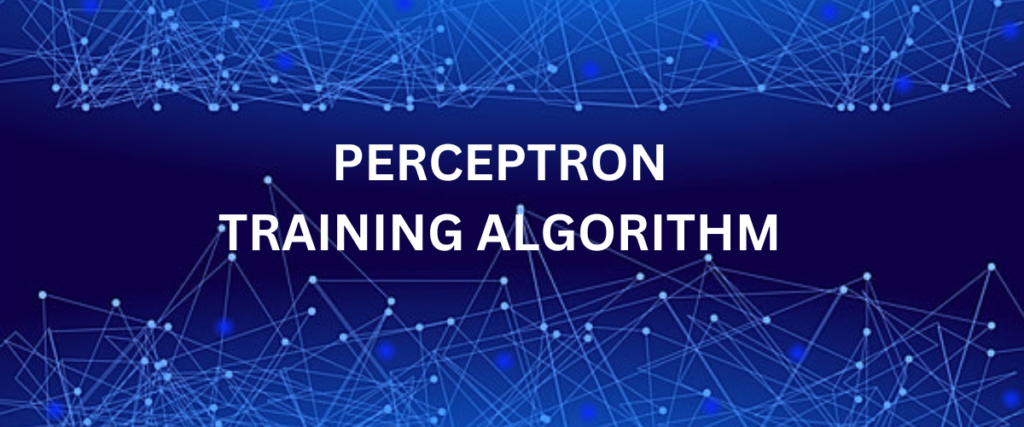Machine Learning and Deep Learning are all about trying to learn and mimic human behavior. It is underrated to say that these technologies are inspired by the working of the human brain to perform complex tasks like finding treatments for diseases(this did happen recently) to autonomous driving cars which we humans never anticipated to happen.
So what is the inspiration for these technologies? Neurons. That’s right! Neural networks are based on something called perceptron – a basic component of a network, which is based on the working of a neuron.
The human brain works beautifully with millions of connections to perform several computations, which forms a basis for artificial neural networks with the foundations lying on a perceptron.
What we are going to do in this post is to delve deep into the concept of perceptron and its learning algorithm.
The perceptron is a fundamental building block in neural networks, pivotal in machine learning and deep learning. It’s a supervised learning algorithm, effectively used in binary classification, logical operations, and pattern recognition. This article dives deep into its origins, key components, learning process, and diverse applications, providing a comprehensive understanding of the perceptron’s role in AI advancements
History of Perceptron
To start, a perceptron is essentially called a building block of a neural network. It can be taken as the simplest form of an artificial neural network. The perceptron forms a foundation for many binary classifier algorithms in machine learning and deep learning. Mr. Frank Rosenblatt described the perceptron in a paper in the mid-20th century (1958).
Coming to Machine Learning, a perceptron model is a simple neural network unit that performs certain computations to detect features or business intelligence in the input data.
It is a supervised learning algorithm and can be considered as a single-layer neural network, meaning there is only one weighted layer and one output unit.
Components of a Perceptron
In this section, we are going to discuss the architecture of a perceptron along with its components.

- Input(X): The information to be processed is accepted into the input features (Xi)
- Weights(w): The weight is a component that decides the importance of an input feature. It is crucial in decision-making as it decides how much importance the input feature has. This parameter can be adjusted during training to optimize the performance (w1,w2,w3……..,wn)
- Bias(b): Unlike the weight parameter which is associated with each input feature, the bias is an independent term, and serves as another tunable or adjustable parameter to optimize the model’s performance
- Weighted Sum: The overall sum of the input features is computed along with the weight parameters for each input. The bias is also added to this sum. The formula for calculating the weighted sum is
z = w1x1+w2x2+……….+wnxn+b where n is the number of nodes - Activation Function(f): The activation function is the MVP since it decides which input feature should be activated or fired. There are three types of activation functions – Sign function, Step function, and Sigmoid function
After the neurons are activated, the output is obtained.
Perceptron Learning or Training Algorithm
The perceptron model follows certain pre-defined steps to classify the input features. The steps are as follows:
Step 1:Initialization of Weights and Bias
Initialize the weights and bias to a small non-negative value(wi b=0) and assume a learning rate(α=1).
Step 2: Calculation of Weighted Sum
For each example:
- Compute the weighted sum: z = w1x1+w2x2+……….+wnxn+b
- Apply the activation or threshold function
f(z) = 1 if z>=0
0 if z<0
Step 3: Weight Adjustment
- If the output z is not equal to the target t, compute the error
E = (z-t)2 - Update the weights and bias using the given update rule
wi(new) = wi(old)+αtxi (for weights)
b(new) = b(old)+ αt (for bias)
This process is repeated until the expected output converges with the actual output (z=t).
Applications of Perceptron
The perceptron model can be used in many real-life scenarios such as:
Binary Classification: Given the input features, the perceptron can learn to classify the data into two different classes based on the weights of the neurons.
Logical Operations: The perceptron can be used to implement basic logic gates such as AND, OR, NOR, and XOR, which form the base for many complex logic gates.
Pattern Recognition: These models can be used in image and speech recognition systems to observe the patterns in image and speech data.
Medical Diagnosis: If we provide the medical symptoms of a person to the perceptron, it can determine if the person is suffering from a certain ailment or not(similar to classification).
Credit Scoring: Based on given financial inputs, perceptrons are used to determine if the individual is worthy of a valid credit score.
Wrapping Up: Perceptron’s Journey in Machine Learning
To briefly summarise, we have discussed the definition of a perceptron. how it is invented, its architecture, and the important components, along with the training algorithm and its applications.
Can you try to code a perceptron model for the AND gate?
